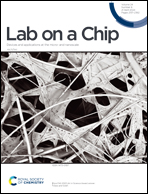Polar coordinate active-matrix digital microfluidics for high-resolution concentration gradient generation†
Abstract
Automated concentration gradient generation is one of the most important applications of lab-on-a-chip devices. Digital microfluidics is a unique platform that can effectively achieve digitalized gradient concentration preparation. However, the dynamic range and concentration resolution of the prepared samples heavily rely on the size and the number of effective electrodes. In this work, we report an active-matrix digital microfluidic device with polar coordinate electrode arrangement. The device contains 33 different electrode sizes, generating digital droplets of different volumes. To compare with the conventional rectangular coordinate arrangement with a similar electrode number, this work shows an approximately 19 times resolution enhancement for the achievable concentration gradient. We characterized the stability and uniformity of droplets generated by electrodes of different sizes, and the coefficient of variation of stable droplets was less than 3%. The fluorescent nanomaterial's concentration quantification and glucose concentration characterization experiments were also conducted, and the correlation coefficients for the linearities were all above 0.99.

- This article is part of the themed collections: Editor’s Choice: Droplet Microfluidics and Editor’s Choice: Digital Microfluidics


 Please wait while we load your content...
Please wait while we load your content...